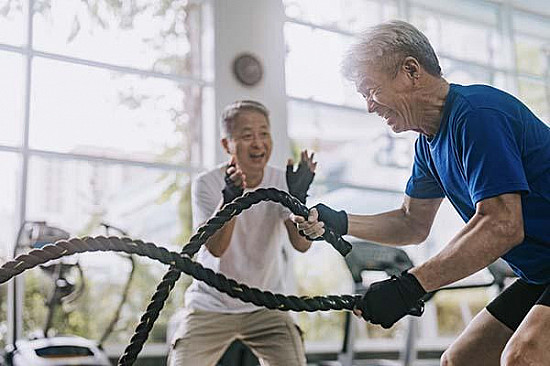[ad_1]

Known for its ability to deliver effective results in less time than traditional workouts, HIIT is a big hit among young fitness enthusiasts. But here’s the good news: HIIT workouts can also benefit the elderly. Here are some tips for seniors to make this style of exercise safe, effective and rewarding.
What is HIIT?
High-intensity interval training (HIIT) is a training style that alternates between intense effort and recovery intervals. The goal of HIIT is to push your body hard during high-intensity intervals and allow it to recover during intervals of low-to-moderate intensity activity.
During the intense exercise sessions of a HIIT session, your heart rate increases. A simple way to determine if you are exercising at a high intensity is to use the talk test. If you can sing while exercising, you are low intensity. If you can have a conversation while exercising, your effort is moderate. When you can’t say more than a few words without having to breathe, you’re working at high intensity.
During recovery periods, your heart rate decreases from this peak, but still remains elevated relative to your baseline. This sustained increase means that a HIIT workout burns more calories and improves cardiovascular fitness more effectively than sustained, moderate-intensity exercise. The structure of HIIT makes it very effective, helping you achieve maximum benefits in minimum time.
A HIIT workout consists of four essential parts:
- a warm-up of low-intensity movements targeting the same muscles as the main workout
- high-intensity intervals during which you increase speed, resistance, or incline to maximize your effort
- Recovery intervals, or active rest periods, equal to or slightly longer in duration than high-intensity intervals
- recovery with light activity such as walking or walking.
One of the most attractive features of high intensity interval training is its flexibility. Cardio, strength, or combination workouts can be transformed into interval sessions by increasing the incline, speed, or resistance to create high-intensity intervals and alternating these with recovery intervals.
Key Benefits of HIIT: Improve Cardiovascular Health and Strength
HIIT workouts offer significant health benefits. Below are some key benefits of incorporating HIIT into your routine:
- Improves aerobic fitness. HIIT has been shown to increase VO2 maxa measure of the amount of oxygen your body consumes during exercise and the best available measure of aerobic fitness. This increase occurs in all age groups.
- Benefits for heart health. Interval training strengthens the heart muscle and improves cardiovascular health. Periodic increases in your heart rate during HIIT sessions promote more efficient use of oxygen.
- Stimulates metabolic function. HIIT improves the function of mitochondria, tiny energy generators found in every cell in your body.
- Builds muscle. According to studies, HIIT can increase lean body mass, which includes muscle, by 1 to 3 percent. This is important for older people who are beginning to lose muscle at increased rates as they age.
- Preserves muscle power. HIIT helps maintain fast-twitch muscle fibers, essential for rapid, explosive movements. This is especially important because fast-twitch fibers naturally decline with age, making activities that require sudden bursts of energy more difficult.
- Fast results. Research shows that HIIT can lead to fitness benefits faster than traditional steady-state workouts. A 20-minute HIIT session burns more calories and strengthens the heart than 20 minutes of moderate-intensity exercise.
Modifications and Precautions: Adapting HIIT to Your Abilities
Remember that intensity depends on your fitness level: what feels intense to you may be different to someone else. Avoid trying to keep up with younger or more experienced athletes. Instead, focus on gradually increasing your own challenge. Even small efforts can improve your fitness.
If you’re older or haven’t exercised in a while, modify high-intensity interval training as needed based on your current fitness level. For example, you may not need to run as fast or use as much resistance to get your heart rate up as the person next to you at the gym.
Consult your doctor before starting a HIIT program, especially if you have any health conditions. If you have heart disease, diabetes, or high blood pressure, use extra caution and consult a healthcare professional before incorporating high-intensity efforts into your routine. Call 911 immediately if you experience upper body discomfort, including chest pain, shortness of breath, or fainting during or after exercise.
In terms of frequency, you don’t have to do HIIT workouts every day, nor should you. In fact, HIIT is only recommended two to three times per week.
Getting started with HIIT
Starting HIIT as an older adult doesn’t have to be intimidating. You can get all the benefits of HIIT just by changing the exercise you do today. The key is to start with manageable intervals and gradually increase the intensity as your fitness improves.
For example, if you usually walk for 30 minutes, try walking at your normal pace for five minutes, then walk as quickly as possible or jog for one minute. Then return to your usual pace for three minutes. Repeat this cycle several times.
If your favorite exercise is swimmingyou can try alternating a leisurely lap with one or two laps of swimming at a challenging pace. Work your way up to repeating this pattern for 30 minutes.
As you get stronger, you can increase the duration and intensity of higher intensity intervals while reducing recovery periods. Always listen to your body and progress at a pace that suits you.
Some soreness after a workout is normal, but tell your doctor if you experience persistent or severe muscle soreness that begins during or immediately after a workout, or if your muscle soreness lasts more than one to two weeks .
[ad_2]
Source link
